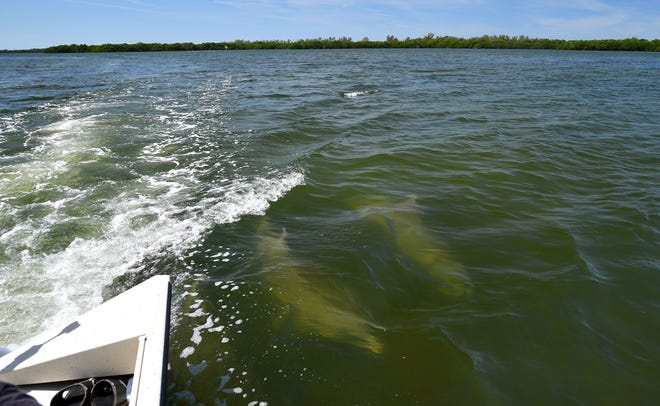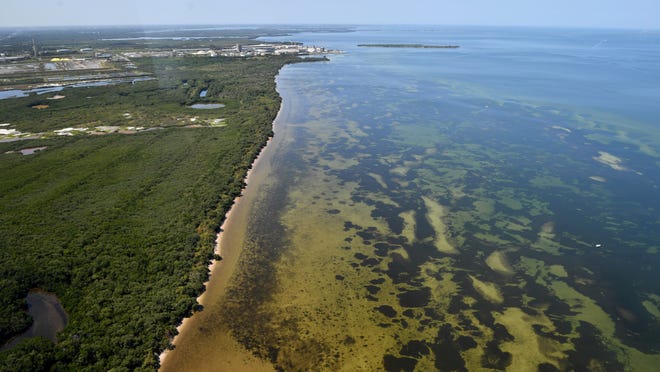Piney Point: USF and Sarasota Dolphin Research Program to study environmental impact of crisis
Timothy Fanning
Sarasota Herald-Tribune
PALMETTO – As the Piney Point environmental crisis has drawn national attention, ecological groups have raised alarms over the impact that the pumping of polluted water will have on Tampa Bay and its natural inhabitants.
A team of scientists at the University of South Florida College of Marine Sciences has responded by embarking on the first research cruise in Tampa Bay dedicated to studying the environmental impact of the leaking from a wastewater holding pond at Piney Point and the ensuing emergency dumping of tens of millions of gallons of polluted water into the bay.
The team will collect water samples, surface sediment and fish from Tampa Bay and Port Manatee. Researchers hope to answer how the changes in water chemistry affect marine life.
In case you missed it:Discharges of polluted wastewater from Piney Point into Tampa Bay reduced by 90%
More like this:Top Florida environmental regulator implies agency should have closed Piney Point years ago

Separately this week, the National Oceanic and Atmospheric Administration and staff from the Chicago Zoological Society’s Sarasota Dolphin Research Program announced that it has begun monitoring the dolphins in the area surrounding the gypsum stack spill.
The Sarasota Dolphin Research Program, a leading dolphin research organization, has maintained the world’s longest longitudinal study of dolphins in the wild.
Earlier this week:Dumping of polluted wastewater from Piney Point continues, DEP working to treat water
Through research measures such as dolphin surveys and seasonal monitoring of dolphin prey fish, the Sarasota Dolphin Research Program helps scientists learn about dolphin biology, environmental impacts on their health and reproductive success, their social structure and the effects of human activities.
Applying some of the approaches the team uses with Sarasota Bay’s dolphins to the emerging situation in Tampa Bay, the state’s largest estuary, the organization will work to understand the effects the spill has had on local wildlife.

The Sarasota Dolphin Research Program is trying to identify:
Which dolphins are being exposed to the highest concentrations of discharged waters (many are individually identifiable).
How dolphin distributions may have changed in response to the discharges.
Whether dolphins are having respiratory issues, exhibiting abnormal behavior or developing unusual skin conditions.
If dolphins have left the area, where they went.
The group has conducted photo-identification research in the area near Port Manatee from 1988 to 1993. It has also identified a resident dolphin community adjoining that of Sarasota Bay.
And :Scientists have been studying Sarasota-area dolphins for 50 years; what have they learned?
“Since the discharge began, we have seen many fewer dolphins in the area than we did in our earlier surveys, and they are mostly more than two miles from the discharge site. These findings are preliminary, and the situation is changing daily,” said Randall Wells, director of the program.

On Wednesday, a team of scientists at USF launched the the university’s Weatherbird II research vessel. The vessel previously monitored the Deepwater Horizon oil spill in 2010.
The research team is being led by USF chemical oceanographer Kristen Buck and biological oceanographer Steve Murawski.
College of Marine Science Dean Tom Frazer said in a university news release that “rapid deployments like this one provide us with an unprecedented opportunity to get out there and provide the science necessary to inform an effective response, as well as any necessary mitigation efforts, so that we can safeguard our vulnerable coastal resources.”

The scope of the work by the Sarasota Dolphin Research Program remains to be fully defined, temporally and geographically, and depends on how the spill develops.
In addition to providing essential baseline data for both the conservation of dolphins in the wild and their welfare in zoos, the program will continue to contribute to management actions that help mitigate negative influences humans can have on marine ecosystems.
More: Florida Senate seeks to use federal COVID relief money to clean up Piney Point site
For now, no government funds have been available to cover program expenses.
The Charles & Margery Barancik Foundation has diverted existing funding to the organization to aid the Tampa Bay efforts and is attempting to raise more money.
“Dolphins have been long considered our water-based ecological sentinels – breathing the same air, swimming in the same waters and eating the same fish we do,” said Teri A Hansen, the president and CEO of the Barancik Foundation. “If we can identify what effects this crisis has on them, we can better understand what risks it poses for our own health and hope others lend their philanthropic support to this important work.”
No comments:
Post a Comment